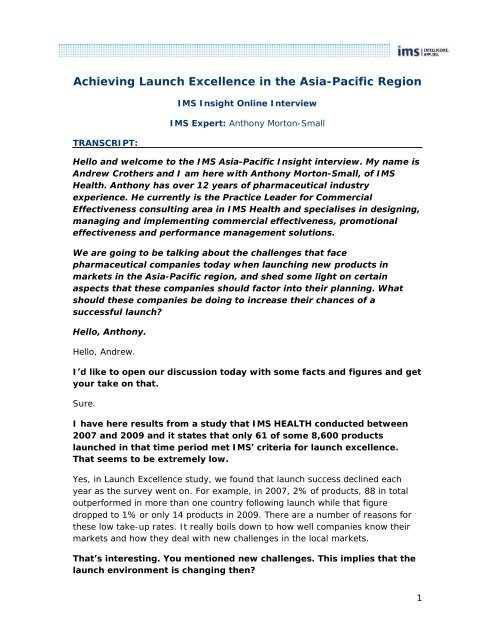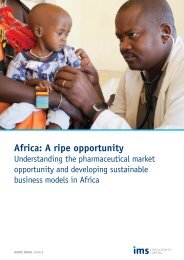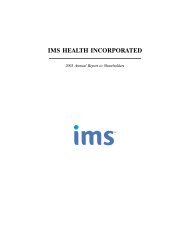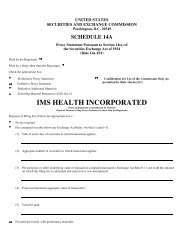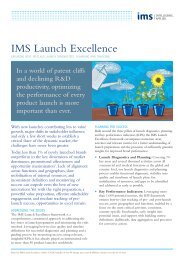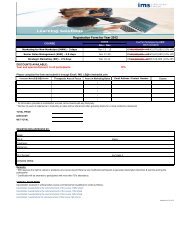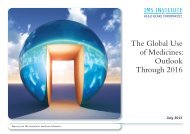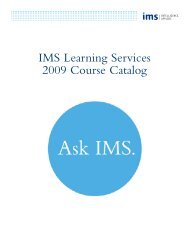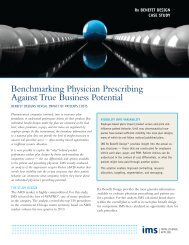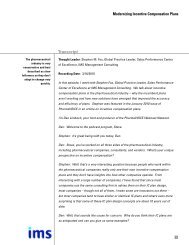Achieving Launch Excellence in Asia-Pacific Transcript ... - IMS Health
Achieving Launch Excellence in Asia-Pacific Transcript ... - IMS Health
Achieving Launch Excellence in Asia-Pacific Transcript ... - IMS Health
You also want an ePaper? Increase the reach of your titles
YUMPU automatically turns print PDFs into web optimized ePapers that Google loves.
<strong>Achiev<strong>in</strong>g</strong> <strong>Launch</strong> <strong>Excellence</strong> <strong>in</strong> the <strong>Asia</strong>-<strong>Pacific</strong> Region<br />
TRANSCRIPT:<br />
<strong>IMS</strong> Insight Onl<strong>in</strong>e Interview<br />
<strong>IMS</strong> Expert: Anthony Morton-Small<br />
Hello and welcome to the <strong>IMS</strong> <strong>Asia</strong>-<strong>Pacific</strong> Insight <strong>in</strong>terview. My name is<br />
Andrew Crothers and I am here with Anthony Morton-Small, of <strong>IMS</strong><br />
<strong>Health</strong>. Anthony has over 12 years of pharmaceutical <strong>in</strong>dustry<br />
experience. He currently is the Practice Leader for Commercial<br />
Effectiveness consult<strong>in</strong>g area <strong>in</strong> <strong>IMS</strong> <strong>Health</strong> and specialises <strong>in</strong> design<strong>in</strong>g,<br />
manag<strong>in</strong>g and implement<strong>in</strong>g commercial effectiveness, promotional<br />
effectiveness and performance management solutions.<br />
We are go<strong>in</strong>g to be talk<strong>in</strong>g about the challenges that face<br />
pharmaceutical companies today when launch<strong>in</strong>g new products <strong>in</strong><br />
markets <strong>in</strong> the <strong>Asia</strong>-<strong>Pacific</strong> region, and shed some light on certa<strong>in</strong><br />
aspects that these companies should factor <strong>in</strong>to their plann<strong>in</strong>g. What<br />
should these companies be do<strong>in</strong>g to <strong>in</strong>crease their chances of a<br />
successful launch?<br />
Hello, Anthony.<br />
Hello, Andrew.<br />
I’d like to open our discussion today with some facts and figures and get<br />
your take on that.<br />
Sure.<br />
I have here results from a study that <strong>IMS</strong> HEALTH conducted between<br />
2007 and 2009 and it states that only 61 of some 8,600 products<br />
launched <strong>in</strong> that time period met <strong>IMS</strong>’ criteria for launch excellence.<br />
That seems to be extremely low.<br />
Yes, <strong>in</strong> <strong>Launch</strong> <strong>Excellence</strong> study, we found that launch success decl<strong>in</strong>ed each<br />
year as the survey went on. For example, <strong>in</strong> 2007, 2% of products, 88 <strong>in</strong> total<br />
outperformed <strong>in</strong> more than one country follow<strong>in</strong>g launch while that figure<br />
dropped to 1% or only 14 products <strong>in</strong> 2009. There are a number of reasons for<br />
these low take-up rates. It really boils down to how well companies know their<br />
markets and how they deal with new challenges <strong>in</strong> the local markets.<br />
That’s <strong>in</strong>terest<strong>in</strong>g. You mentioned new challenges. This implies that the<br />
launch environment is chang<strong>in</strong>g then?<br />
1
Yes that’s right. Companies are acknowledg<strong>in</strong>g, but not yet consistently<br />
respond<strong>in</strong>g to, the new demands of the chang<strong>in</strong>g launch environment. The issues<br />
are essentially threefold. Firstly, we are see<strong>in</strong>g different decisions makers today.<br />
The traditional prescriber-based sales model is <strong>in</strong>effective <strong>in</strong> commodity markets.<br />
Companies need to address all stakeholders and not simply the prescribers these<br />
days.<br />
I see.<br />
Secondly, there are different market dynamics. Fewer launches today are<br />
achiev<strong>in</strong>g an even modest therapy market share of let’s say 5% <strong>in</strong> their first year.<br />
We are see<strong>in</strong>g today that even the best market share uptakes are not as high as<br />
previous years.<br />
What would be the reason for that then?<br />
Well, really it is to do with a decl<strong>in</strong>e <strong>in</strong> the impact of the traditional market model<br />
externally, and <strong>in</strong>ternally it’s more to do with a lack of preparation and read<strong>in</strong>ess<br />
to launch as well as a failure to align objectives, and identify and <strong>in</strong>centivise<br />
payers & policy makers.<br />
I see. You mentioned a third reason for launch failure?<br />
Yes, pharmaceutical companies are faced with differ<strong>in</strong>g timescales <strong>in</strong> different<br />
countries. Companies need to understand the optimal range and tim<strong>in</strong>g of<br />
prelaunch activity at a global and at the country level. Most importantly,<br />
companies are not capitalis<strong>in</strong>g on opportunities presented <strong>in</strong> the first six months<br />
of launch, and our research and experience shows that the sales seen dur<strong>in</strong>g this<br />
crucial period determ<strong>in</strong>e sales thereafter.<br />
So companies really need to make an impact <strong>in</strong> the first six months of<br />
launch.<br />
Actually I would say now that we can narrow that w<strong>in</strong>dow even further to the<br />
first three months as we have seen <strong>in</strong> our 2008 study that with<strong>in</strong> the six-month<br />
w<strong>in</strong>dow there lurked an even shorter critical time frame; on average, three<br />
months is the period <strong>in</strong> which a launch agent establishes its share of the dynamic<br />
market <strong>in</strong> its therapy area. In other words, it has become evident that sales<br />
efforts <strong>in</strong> the first three months tend to determ<strong>in</strong>e sales trends for the first two<br />
years of a product’s life cycle.<br />
Really, it’s as short a period as that? That’s a real challenge then.<br />
Well, yes it is. But it is with<strong>in</strong> the power of companies to make a success of a<br />
launch by be<strong>in</strong>g fully prepared while adapt<strong>in</strong>g to the dynamic market to ensure<br />
that the <strong>in</strong>itial launch trajectory of a new product is created by the drug be<strong>in</strong>g<br />
2
prescribed for new patients, by hav<strong>in</strong>g exist<strong>in</strong>g patients switched to it or by<br />
be<strong>in</strong>g added on to their exist<strong>in</strong>g regimens.<br />
OK, so we have identified the 3 issues fac<strong>in</strong>g companies launch<strong>in</strong>g new<br />
products. How should they be address<strong>in</strong>g them, s<strong>in</strong>ce you say that it is<br />
<strong>in</strong> their power to make a difference?<br />
Well, tak<strong>in</strong>g the first po<strong>in</strong>t about deal<strong>in</strong>g with different decision makers,<br />
companies should have a powerful and pert<strong>in</strong>ent value proposition for the<br />
product that is compell<strong>in</strong>g and differentiated from the exist<strong>in</strong>g therapies <strong>in</strong> the<br />
category. This means ensur<strong>in</strong>g their messag<strong>in</strong>g are consistent yet adapted to the<br />
different decision maker audiences, and aligned through country communication.<br />
That can be quite a challenge. Can you give any advice on how this can<br />
be done?<br />
Yes, of course. For example, to do this successfully with payers, pharmacos need<br />
to understand payer motivations such as budget impact, cost-effectiveness and<br />
therapeutic value to meet the value criteria necessary for optimal approval. It<br />
comes down to understand<strong>in</strong>g and cater<strong>in</strong>g to your audience.<br />
OK, so gett<strong>in</strong>g the value proposition for the product right for each target<br />
audience is crucial. What specific actions should companies be tak<strong>in</strong>g<br />
prior to launch to communicate their value proposition effectively?<br />
Firstly, companies need to identify who is responsible for the fund<strong>in</strong>g flows and<br />
formulary decisions for the related disease areas both now and <strong>in</strong> the future.<br />
Then they need to identify the decision makers controll<strong>in</strong>g these fund<strong>in</strong>g flows<br />
and understand what drives their buy<strong>in</strong>g decisions. From here they can craft<br />
their value proposition for new products dur<strong>in</strong>g the Phase Three of cl<strong>in</strong>ical trials,<br />
and keep build<strong>in</strong>g momentum and <strong>in</strong>terest throughout the trials and beyond <strong>in</strong><br />
terms of real world patient outcomes and value over other therapies.<br />
Right so it is an ongo<strong>in</strong>g process.<br />
That’s right. And dur<strong>in</strong>g the launch process they should be segment<strong>in</strong>g payers<br />
and target areas of the value dossier accord<strong>in</strong>gly. Obviously they also need to<br />
build the commercial go-to-market strategy <strong>in</strong> tandem.<br />
And what about deal<strong>in</strong>g with the different market dynamics you<br />
mentioned at the beg<strong>in</strong>n<strong>in</strong>g?<br />
Companies need to build long-term launch strategies for non-prescrib<strong>in</strong>g<br />
customers through an effective stakeholder engagement strategy. This is<br />
required to drive market expansion. They need to consider all stakeholders such<br />
as policy makers, payers, patients and prescribers. It’s not enough anymore to<br />
target just prescribers.<br />
3
So the key is to target all stakeholders then.<br />
Exactly right. Roche is a good example with the success of their oncology<br />
products <strong>in</strong> a many geographies. They were basically more prepared. They found<br />
a local strategy <strong>in</strong> each country, they made a success of engag<strong>in</strong>g all<br />
stakeholders, and that <strong>in</strong>cludes patients, they worked out how to best work with<br />
payers <strong>in</strong> the local context.<br />
So it proves it can be done with more preparation and an <strong>in</strong>-depth<br />
understand<strong>in</strong>g of the <strong>in</strong>dividual market. But how do companies manage<br />
the different timescales?<br />
There needs to be strong governance of the launch strategy across functions and<br />
geographies with a focus on quality and timel<strong>in</strong>ess.<br />
I see, so everyone work<strong>in</strong>g to common objectives and strategies<br />
relevant to their area.<br />
Yes that’s right. Basically it comes down to the right <strong>in</strong>ternal alignment and<br />
measurements of the launch strategy. Companies that have succeeded at launch<br />
did well <strong>in</strong> build<strong>in</strong>g alignment <strong>in</strong>to their plann<strong>in</strong>g process, creat<strong>in</strong>g enterprisewide<br />
launch focus, and benchmark<strong>in</strong>g and track<strong>in</strong>g performance consistently.<br />
So the launch process needs to be managed from the top down.<br />
Not necessarily, but centrally driven yes. Certa<strong>in</strong>ly senior management<br />
leadership is crucial for sett<strong>in</strong>g the broad direction. When launches have been<br />
unsuccessful, we have seen that wrong expectations have been set <strong>in</strong> terms of<br />
over promis<strong>in</strong>g or ignor<strong>in</strong>g potential. Also there tended to be an <strong>in</strong>sistence on<br />
global policies be<strong>in</strong>g followed that work <strong>in</strong> the US or EMEA perhaps but don’t<br />
work elsewhere. As I mentioned before, it all comes down to know<strong>in</strong>g your<br />
market.<br />
A case of one size does not fit all.<br />
Precisely. Companies need to work out the dynamics <strong>in</strong> <strong>in</strong>dividual markets and<br />
work that market locally.<br />
So, you’ve mentioned an <strong>in</strong>terest<strong>in</strong>g po<strong>in</strong>t, that what works <strong>in</strong> one<br />
market does not work <strong>in</strong> other countries necessarily. Let’s look<br />
specifically at the <strong>Asia</strong> <strong>Pacific</strong> market now and the localisation that<br />
needs to take place.<br />
Well, as I’ve just mentioned, the crux of the matter is know<strong>in</strong>g your market and<br />
be<strong>in</strong>g able to adapt your strategies to local markets. Failures <strong>in</strong> the past clearly<br />
resulted from the failure of companies to capitalise on opportunities.<br />
What k<strong>in</strong>ds of opportunities were typically missed?<br />
4
For example, the companies failed to develop a deep understand<strong>in</strong>g of the<br />
<strong>in</strong>digenous economies, historical trends, cultural predilections and public policy<br />
among other th<strong>in</strong>gs. The launch was compromised <strong>in</strong> each case as a result. They<br />
needed to consider that the approaches they had been us<strong>in</strong>g <strong>in</strong> Western markets<br />
might not fit local circumstances. What will work <strong>in</strong> the US for example is not<br />
necessarily go<strong>in</strong>g to work <strong>in</strong> Korea.<br />
Of course. So homework was not done then.<br />
To a certa<strong>in</strong> extent, yes, but you have to remember that these markets were<br />
generally unknown territory. And other factors contributed as well, such as an<br />
absence of clear forecast<strong>in</strong>g data <strong>in</strong> these emerg<strong>in</strong>g markets, compounded by<br />
the fact that the majority of patients were undiagnosed, under compliant or<br />
under served. With a lack of data on the true healthcare system <strong>in</strong> the target<br />
country, it is difficult for pharmaceutical companies to adequately plan launches.<br />
And of course there are the challenges faced with <strong>Asia</strong> be<strong>in</strong>g such a dynamic<br />
market.<br />
What do you mean by that?<br />
Well, markets <strong>in</strong> <strong>Asia</strong> are chang<strong>in</strong>g all the time. So launch pr<strong>in</strong>ciples have to be<br />
revised more often than would be necessary <strong>in</strong> a traditional market, which isn’t<br />
go<strong>in</strong>g to change much over time. To give you an example, the market <strong>in</strong> Ch<strong>in</strong>a<br />
has changed beyond all recognition from the market it was a year ago, so launch<br />
pr<strong>in</strong>ciples that were used last year simply won’t be appropriate today. In some<br />
countries, the landscape changes so fast that strategies have to be revised even<br />
dur<strong>in</strong>g the launch process itself.<br />
So what k<strong>in</strong>ds of changes take place <strong>in</strong> these markets that can have<br />
such an impact on launch success or failure?<br />
It can be <strong>in</strong>troduction of new regulations, government reforms, changes <strong>in</strong><br />
<strong>in</strong>surance regulations, or more drastically, policy change as a result of a change<br />
of leadership follow<strong>in</strong>g an election can change the potential success and entire<br />
outlook for a launch overnight – for <strong>in</strong>stance <strong>in</strong> the US with the pass<strong>in</strong>g of the<br />
<strong>Health</strong>care Reform legislation creat<strong>in</strong>g expanded coverage for un<strong>in</strong>sured<br />
Americans. In the <strong>Asia</strong>n context, the healthcare reform activities <strong>in</strong> Ch<strong>in</strong>a as well<br />
as is the impact of mandatory drug pric<strong>in</strong>g controls on generic supply driven by<br />
the recent elections <strong>in</strong> the Philipp<strong>in</strong>es.<br />
I see. So how can pharmas be better prepared to launch?<br />
At <strong>IMS</strong> <strong>Health</strong>, we have identified the five drivers for launch uptake <strong>in</strong> any<br />
country are Advocacy, Approval, Access, Adoption and Adherence. But <strong>in</strong><br />
addition, companies need to consider what we call the Three As of pharma<br />
5
market<strong>in</strong>g; Awareness, Accessibility and Affordability. Let me just quickly cover<br />
these one by one.<br />
Certa<strong>in</strong>ly. You mentioned awareness as be<strong>in</strong>g the first of the three.<br />
Yes, Awareness. MNCs need to actually create the market for their drugs by<br />
educat<strong>in</strong>g patients and physicians on the benefits and value of this medic<strong>in</strong>e over<br />
others, and as mentioned before, all stakeholders. To do this, they need a<br />
thorough understand<strong>in</strong>g of disease states, therapeutic options and the potential<br />
fall-out of non-compliance. Innovative outreach programmes are needed such as<br />
key collaborations, sponsorship of a family network support, language translation<br />
and so on.<br />
And the second A, which is Accessibility?<br />
Accessibility to medic<strong>in</strong>es (<strong>in</strong> terms of healthcare <strong>in</strong>frastructure) is a major<br />
challenge as there are substantial variations <strong>in</strong> availability between say urban<br />
and rural environments <strong>in</strong> emerg<strong>in</strong>g <strong>Asia</strong>n markets. Companies, therefore, need<br />
to pay particular attention to local access to diagnosis, prescrib<strong>in</strong>g & dispens<strong>in</strong>g<br />
stations and distribution channels to ensure their products are economically<br />
supplied, targeted accurately and get to market where there are access<br />
challenges.<br />
I would suppose relationship build<strong>in</strong>g would be a critical component of<br />
their strategy?<br />
Actually, no not necessarily . Sometimes quite the opposite <strong>in</strong> emerg<strong>in</strong>g markets,<br />
<strong>in</strong> fact.<br />
Oh really?<br />
Yes. Companies need to realise that relationship-sell<strong>in</strong>g is not always go<strong>in</strong>g to<br />
work as well <strong>in</strong> these emerg<strong>in</strong>g markets, where the local manufacturers will have<br />
the relationship advantage. They need to be prepared to prove their products<br />
value over local therapies through <strong>in</strong>-country cl<strong>in</strong>ical trial data, which may<br />
require additional <strong>in</strong>vestment.<br />
Yes, I can see how that will be a major difference to market<strong>in</strong>g <strong>in</strong> their<br />
established markets. And the third A, I am guess<strong>in</strong>g, would be<br />
Affordability.<br />
That’s exactly it. Naturally pric<strong>in</strong>g is a concern <strong>in</strong> any market but it is<br />
particularly sensitive <strong>in</strong> APAC, where <strong>in</strong>flation, GDP growth, ris<strong>in</strong>g <strong>in</strong>comes and<br />
elevated expectations make price a crucial buy<strong>in</strong>g decision. GlaxoSmithKl<strong>in</strong>e <strong>in</strong><br />
India is a prime example of a company operat<strong>in</strong>g a local pric<strong>in</strong>g strategy across<br />
its portfolio. In Ch<strong>in</strong>a, we see different pric<strong>in</strong>g strategies between urban and<br />
6
ural markets. MNCs can also meet the challenge by partner<strong>in</strong>g with local<br />
manufacturers and suppliers and seek<strong>in</strong>g possible tax exemptions.<br />
That’s an <strong>in</strong>terest<strong>in</strong>g po<strong>in</strong>t. So apply<strong>in</strong>g the three As is crucial when<br />
launch<strong>in</strong>g <strong>in</strong> APAC. What assistance is there for companies available<br />
from <strong>IMS</strong> HEALTH?<br />
Well, <strong>IMS</strong> HEALTH is well positioned to help MNCs avoid common pitfalls and<br />
strengthen the three Foundational Success factors of determ<strong>in</strong><strong>in</strong>g and optimis<strong>in</strong>g<br />
their product’s value proposition, effectively and efficiently engag<strong>in</strong>g<br />
stakeholders, mapp<strong>in</strong>g out resource allocation and monitor<strong>in</strong>g and driv<strong>in</strong>g<br />
performance, as well as align<strong>in</strong>g and prepar<strong>in</strong>g these organisations for launch.<br />
I see. You mentioned common pitfalls just now. Can you give us some<br />
examples of what these typically are?<br />
Yes, certa<strong>in</strong>ly. What we see often is that companies don’t tend to learn from past<br />
launch mistakes not just <strong>in</strong> target<strong>in</strong>g their audiences better, but also they tend<br />
to under-estimate their own constra<strong>in</strong>ts, they don’t give themselves enough time<br />
to prepare, and don’t adopt a consistent framework to drive the launch execution<br />
process to ensure plans are followed through.<br />
What can happen as a result?<br />
They can fail to get their product listed on formulary, or payers won’t accept<br />
their value proposition, or they could fail to forecast the demand <strong>in</strong> <strong>Asia</strong>, or fail<br />
to drill down to the base of the socio economic pyramid, to the patients, and<br />
understand patients’ capacity to spend on medic<strong>in</strong>es. These are all issues <strong>IMS</strong><br />
HEALTH can help companies avoid.<br />
I suppose companies can also take advantage of <strong>IMS</strong>’ <strong>in</strong>-depth<br />
knowledge of the market they <strong>in</strong>tend to launch, and services to help<br />
them achieve better success as they prepare to launch <strong>in</strong>to those<br />
markets.<br />
Very much so. We are well positioned to assist <strong>in</strong> a number of ways. As you<br />
mentioned, we have deep therapeutic market knowledge and competitive <strong>in</strong>sight<br />
so we can advise on the complex competitive dynamics <strong>in</strong> today’s chang<strong>in</strong>g<br />
markets. Secondly, we can advise on market<strong>in</strong>g approaches to take <strong>in</strong> <strong>in</strong>dividual<br />
markets.<br />
Your analytical tools are also known to be pretty effective.<br />
Yes, us<strong>in</strong>g <strong>IMS</strong> Radar Dynamics, APLD, primary market research and enhanced<br />
promotional audits, we have country-by-country evidence-based <strong>in</strong>sight <strong>in</strong>to<br />
market<strong>in</strong>g tactics and success drivers.<br />
7
Right. As well as supply<strong>in</strong>g the needed <strong>in</strong>formation, how else can <strong>IMS</strong><br />
HEALTH add value to the launch process?<br />
Our clients are up aga<strong>in</strong>st competitors that may have significant resources and<br />
effective market<strong>in</strong>g and sales force spend. We have designed specific<br />
methodologies and tools to help our clients’ <strong>in</strong>vestment stays focused and<br />
effective by optimis<strong>in</strong>g <strong>in</strong>vestments <strong>in</strong> the commercial plann<strong>in</strong>g and execution<br />
stages.<br />
Great, well, this has been a very <strong>in</strong>terest<strong>in</strong>g topic. Is there any<br />
additional advice you would like to give before we wrap this up?<br />
Well, <strong>in</strong> summary, I would say that MNCs should adopt a 5-tier strategy for entry:<br />
One: Act Fast, Two: Understand, Three: Differentiate, Four: Tailor and Five:<br />
Execute. And know that your success is dependent on the first 3 months of<br />
launch.<br />
Each of those po<strong>in</strong>ts is self explanatory, and I would imag<strong>in</strong>e each are<br />
equally as important. So let me just repeat them aga<strong>in</strong>. It’s Act Fast,<br />
Understand, Differentiate, then…?<br />
Tailor to the market and Execute well.<br />
Tailor and Execute. OK. So, <strong>in</strong> summary, achiev<strong>in</strong>g launch excellence<br />
really depends on understand<strong>in</strong>g and cater<strong>in</strong>g to the local market,<br />
engag<strong>in</strong>g all stakeholders and align<strong>in</strong>g strategies for launch success.<br />
Anthony, thank you very much for talk<strong>in</strong>g to us today and provid<strong>in</strong>g an<br />
enlighten<strong>in</strong>g <strong>in</strong>sight <strong>in</strong>to the challenges and solutions to launch<strong>in</strong>g<br />
pharma products <strong>in</strong> the <strong>Asia</strong> <strong>Pacific</strong> region. Thank you.<br />
It was my pleasure. Thank you Andrew.<br />
Contact Us!<br />
For questions or comments regard<strong>in</strong>g this <strong>IMS</strong> Insight onl<strong>in</strong>e <strong>in</strong>terview, please<br />
contact <strong>in</strong>fo.sg@sg.imshealth.com.<br />
8


